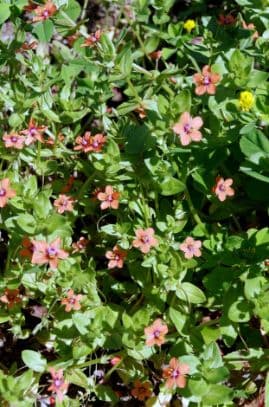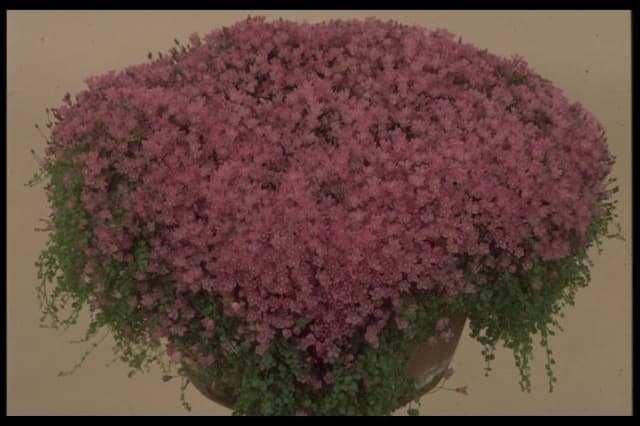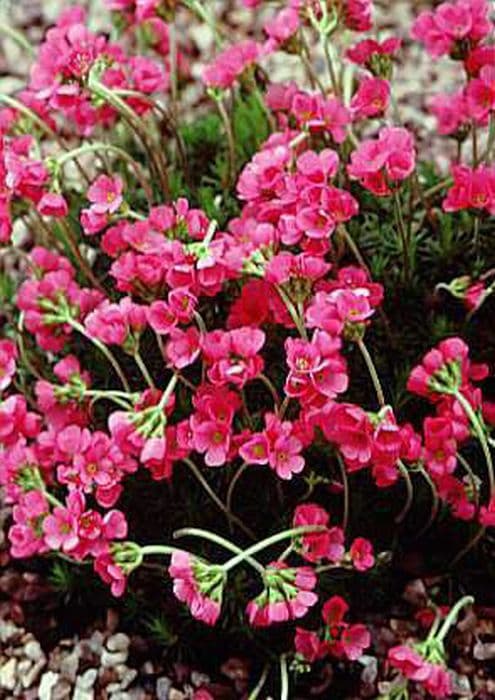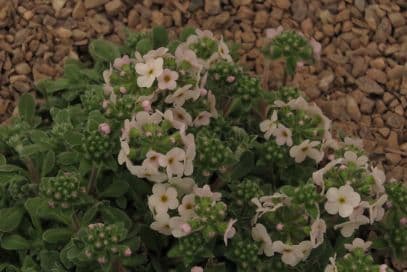False Iberian cyclamen Cyclamen pseudibericum

ABOUT
C. pseudibericum is a tuberous perennial to 12cm in height, with broadly heart-shaped, grey-marbled leaves reddish beneath and fragrant, bright magenta-pink flowers 2.5cm in width in winter and spring
About this plant
 Names
NamesFamily
Primulaceae
Synonyms
Ivy-Leaved Cyclamen, Sowbread
Common names
Cyclamen pseudibericum Hildebr.
 Characteristics
CharacteristicsLife cycle
Perennials
Foliage type
Evergreen
Color of leaves
Varies
Flower color
Pink
Height
6 inches (15 cm)
Spread
6 inches (15 cm)
Plant type
Bulb
Hardiness zones
7
Native area
Turkey
Benefits
 General Benefits
General Benefits- Aesthetic Appeal: Cyclamen pseudibericum is appreciated for its beautiful and vibrant flowers which add color to gardens and indoor spaces.
- Spring Blooming: It blooms in early spring, providing early nectar for pollinators when few other plants are in flower.
- Compact Growth: Its compact growth habit makes it suited for small gardens, borders, and containers.
- Drought Tolerance: Once established, it is relatively drought-tolerant, requiring minimal watering in the right conditions.
- Seasonal Interest: With its heart-shaped, variegated leaves, it adds texture and interest even when not in bloom.
 Medical Properties
Medical PropertiesThis plant is not used for medical purposes.
 Air-purifying Qualities
Air-purifying QualitiesThis plant is not specifically known for air purifying qualities.
 Other Uses
Other Uses- Cyclamen pseudibericum bulbs can be used as a starch source in times of food scarcity, with proper preparation to remove toxins.
- The flowers of Cyclamen pseudibericum may be crystallized and used as decorative edible elements for desserts, although this is not common and should be done with caution due to potential toxicity.
- The sap of Cyclamen pseudibericum can be used in traditional tanning processes to tan leathers, harnessing its tannin content.
- As a natural insect repellent, compounds found in Cyclamen pseudibericum might deter certain insects when used in botanical extracts.
- Dye can be extracted from the petals of Cyclamen pseudibericum to produce a gentle color for fabrics or artworks.
- The foliage and flowers of the plant can be used in floral arrangements for their unique shape and beauty, although they should not be used where food will be present due to potential toxicity.
- Cyclamen pseudibericum can be planted as part of a garden designed to repel deer and rabbits, which tend to avoid it due to its bitter taste.
- The plant's interesting growth patterns and preference for shady spots make it a useful teaching tool for botany and horticulture studies focusing on shade-tolerant plants.
- The dried and powdered tubers of Cyclamen pseudibericum have historically been used as a laundry starch, but this is not recommended due to the presence of toxic compounds.
- Enthusiasts of natural fragrance may experiment with Cyclamen pseudibericum’s scent in creating personal perfumes, albeit with caution since the plant is not typically used for this purpose and its effects are not well-documented.
Interesting Facts
 Feng Shui
Feng ShuiCyclamen is not used in Feng Shui practice.
 Zodiac Sign Compitability
Zodiac Sign CompitabilityCyclamen is not used in astrology practice.
 Plant Symbolism
Plant Symbolism- Sincere Tenderness: Cyclamen are often associated with feelings of sincere affection and tenderness. They are believed to convey genuine love that is delicate and soft.
- Resignation and Goodbye: Giving someone cyclamen can symbolize a parting or farewell. It's sometimes used to convey feelings of sadness when saying goodbye, implying a wish for positive things despite the departure.
- Deep Love: Cyclamen are also associated with deep love. Their heart-shaped leaves often represent deep, lasting feelings between individuals.
 Water
WaterHardy Cyclamen should be watered during its active growing season, generally from fall to spring, when the soil feels dry to the touch. Water the plant thoroughly until water drips from the drainage holes, approximately every 7 to 14 days, using around 16 ounces of water each time, depending on the size of the pot and the indoor environment. During its dormant period in the summer, reduce watering significantly and only water sparingly to prevent the soil from completely drying out.
 Light
LightHardy Cyclamen thrives best in bright, indirect light. It can also tolerate some morning sun but should be protected from harsh afternoon sunlight. The ideal placement is near a window with a sheer curtain or in a spot that receives plenty of ambient light without direct sun exposure.
 Temperature
TemperatureHardy Cyclamen prefers cooler temperatures, ideally between 50°F and 68°F. It can handle temporary dips down to about 40°F but should be protected from temperatures above 77°F, which can cause the plant to go dormant. Consistent temperatures within the cooler range encourage prolonged flowering and overall health.
 Pruning
PruningPruning Hardy Cyclamen involves removing yellowing or dead leaves and faded flowers to encourage new growth and maintain a tidy appearance. This is best done after flowering, which typically occurs in late winter or early spring. Pruning is needed only occasionally and should be gentle, without cutting into the tuber, to prevent damage to the plant.
 Cleaning
CleaningAs needed
 Soil
SoilCyclamen requires a well-draining soil mix, ideally composed of equal parts potting soil, perlite, and peat moss, with a pH of 5.5 to 7.0 for optimal growth.
 Repotting
RepottingCyclamen should be repotted every couple of years, usually after the blooming season has ended; it's best done when the plant enters dormancy.
 Humidity & Misting
Humidity & MistingCyclamen prefer moderate to high humidity levels, typically around 50-70%, to thrive and sustain their blooms and foliage health.
 Suitable locations
Suitable locationsIndoor
Provide bright, indirect light and cool temperatures for indoor growth of Cyclamen.
Outdoor
Grow Cyclamen in dappled shade, sheltered from intense sun and wind.
Hardiness zone
7-9 USDA
 Life cycle
Life cycleCyclamen pseudibericum, commonly known as Spring Cyclamen or Ivy-leaved Cyclamen, begins its life cycle as a seed, which typically germinates in the autumn. After germination, a tuber is formed, and from this tuber, heart-shaped leaves emerge, often with a beautiful silver-marbled pattern. The plant then enters a growth phase during the cooler months of the year, producing flowers that range from white to purplish-pink with a magenta blotch at the base, usually blooming from late winter into spring. After flowering, the plant sets seed through the process of pollination, often aided by insects. As the warmer summer approaches, the cyclamen goes into dormancy, with the foliage dying back, and rests as a tuber underground until the temperatures cool again, signaling the start of the next growing season. This cycle of growth, flowering, seed production, and dormancy repeats annually, with the tuber growing larger and producing more leaves and flowers as the plant matures.
 Propogation
PropogationPropogation time
Spring-Early Summer
Propogation: Cyclamen pseudibericum, commonly known as the Hardy Cyclamen, is usually propagated through seed. The best time to sow Cyclamen pseudibericum seeds is in the fall, as this simulates natural conditions where seeds drop to the ground and undergo a period of cold stratification during the winter. To propagate by seed, one should sow them in a tray filled with a well-draining soil mix, lightly covering the seeds with soil. The tray should be kept moist and placed in a cool location around 50 to 60 degrees Fahrenheit (10 to 15.5 degrees Celsius). Germination can be erratic, sometimes taking several months. Seedlings should only be transplanted after they have developed a few sets of true leaves, which typically occurs in their second year.









